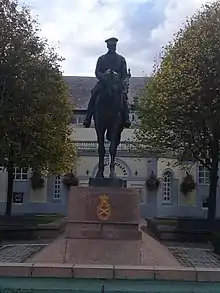Montreuil, Pas-de-Calais
Montreuil (French pronunciation: [mɔ̃tʁœj] (![]() listen); West Flemish: Monsterole), sometimes also called Montreuil-sur-Mer (French pronunciation: [mɔ̃tʁœj syʁ mɛʁ], literally Montreuil on Sea), is a sub-prefecture in the Pas-de-Calais department in northern France. It is located on the Canche river, not far from Étaples. The sea, however, is now some distance away.
listen); West Flemish: Monsterole), sometimes also called Montreuil-sur-Mer (French pronunciation: [mɔ̃tʁœj syʁ mɛʁ], literally Montreuil on Sea), is a sub-prefecture in the Pas-de-Calais department in northern France. It is located on the Canche river, not far from Étaples. The sea, however, is now some distance away.
Montreuil
Monsterole | |
|---|---|
Subprefecture and commune | |
 The town hall of Montreuil-Sur-Mer | |
.svg.png.webp) Coat of arms | |
Location of Montreuil 
| |
 Montreuil  Montreuil | |
| Coordinates: 50°27′53″N 1°45′47″E | |
| Country | France |
| Region | Hauts-de-France |
| Department | Pas-de-Calais |
| Arrondissement | Montreuil |
| Canton | Berck |
| Intercommunality | CA Deux Baies en Montreuillois |
| Government | |
| • Mayor (2020–2026) | Pierre Ducrocq |
| Area 1 | 2.85 km2 (1.10 sq mi) |
| Population (2017-01-01)[1] | 2,014 |
| • Density | 710/km2 (1,800/sq mi) |
| Time zone | UTC+01:00 (CET) |
| • Summer (DST) | UTC+02:00 (CEST) |
| INSEE/Postal code | 62588 /62170 |
| Elevation | 2–43 m (6.6–141.1 ft) |
| 1 French Land Register data, which excludes lakes, ponds, glaciers > 1 km2 (0.386 sq mi or 247 acres) and river estuaries. | |
Sights
Montreuil is surrounded by notable brickwork ramparts, constructed after the destruction of the town by troops of Habsburg emperor Charles V in June 1537.[2] These fortifications pre-date the extensive fortification of towns in northern France by Sébastien Le Prestre de Vauban in the 17th century.
Demographics
Population (1999): 2,688 inhabitants for the city, 21,603 inhabitants for the canton and 99,288 inhabitants for the arrondissement.
History

Montreuil was the headquarters of the British Army in France during the First World War from March 1916 until it closed in April 1919. The military academy there provided excellent facilities for GHQ.
Montreuil was chosen as GHQ for a wide variety of reasons. It was on a main road from London to Paris—the two chief centers of the campaign—though not on a main railway line, which would have been an inconvenience. It was not an industrial town and so avoided the complications alike of noise and of a possibly troublesome civil population. It was from a telephone and motor transit point of view in a very central situation to serve the needs of a Force which was based on Dunkirk, Calais, Boulogne, Dieppe, and Le Havre, and had its front stretching from the River Somme to beyond the Belgian frontier.[3]

Haig staff member Sir Frank Fox OBE wrote a critically acclaimed contemporary account of the headquarters in 1916, originally published under the pseudonym "GSO", called G.H.Q. (Montreuil-sur-Mer) His work in the QMG's Directorate in the final offensive against the German Army resulted in his being awarded the OBE (Military) He was also Mentioned in Despatches.
General Haig was quartered in the nearby Château de Beaurepaire, two miles (3.2 kilometres) southeast of the town on the D138. There is a plaque on the château wall to commemorate this.
King George V, accompanied by Haig, made a triumphant passage through Montreuil on his way to Paris on 27 November 1918.[4]
A statue of Haig on horseback, commemorating his stay, can be seen outside the theatre on the Place Charles de Gaulle.[5] During the German occupation of the town during the Second World War, the statue was taken down. It was never found and is thought to have been melted down. It was rebuilt in the 1950s, using the sculptor's original mould.
Literature
Laurence Sterne visited the town in 1765. He recounted his visit through the eyes of the narrator of his novel A Sentimental Journey Through France and Italy (1768).
Montreuil is the setting for part of Victor Hugo's novel Les Misérables, where it is identified only as M____-sur-M__ in past translations. The protagonist, Jean Valjean (going by the name Monsieur Madeleine), is for a few years the mayor of Montreuil, as well as owner of the local factory, and it is where the character Fantine lives, works, and later becomes a prostitute before dying in a local hospital. Hugo had spent several vacations in Montreuil.[6]
Gallery
 Church, Montreuil
Church, Montreuil Walls of Montreuil
Walls of Montreuil Ramparts
Ramparts Chapelle Sainte-Austreberthe
Chapelle Sainte-Austreberthe A street in Montreuil-sur-Mer
A street in Montreuil-sur-Mer Église abbatiale Saint-Saulve
Église abbatiale Saint-Saulve
References
- "Populations légales 2017". INSEE. Retrieved 6 January 2020.
- http://www.ville-montreuil-sur-mer.fr/histoire/
- Fox, Sir Frank (1920). G.H.Q. (Montreuil-sur-Mer). Beaumont Fox 2nd edition 2015. p. 20.
- "MONTREUIL-SUR-MER: BRITISH GHQ ON THE WESTERN FRONT". remembrancetrails.
- "Statue équestre du Field Marshal Douglas Haig - Montreuil-sur-Mer".
- Edward Behr, The Complete Book of Les Misérables (Arcade, 1993), 29
- "British towns twinned with French towns". Archant Community Media Ltd. Retrieved 2013-07-11.
External links
| Wikimedia Commons has media related to Montreuil-sur-Mer. |
